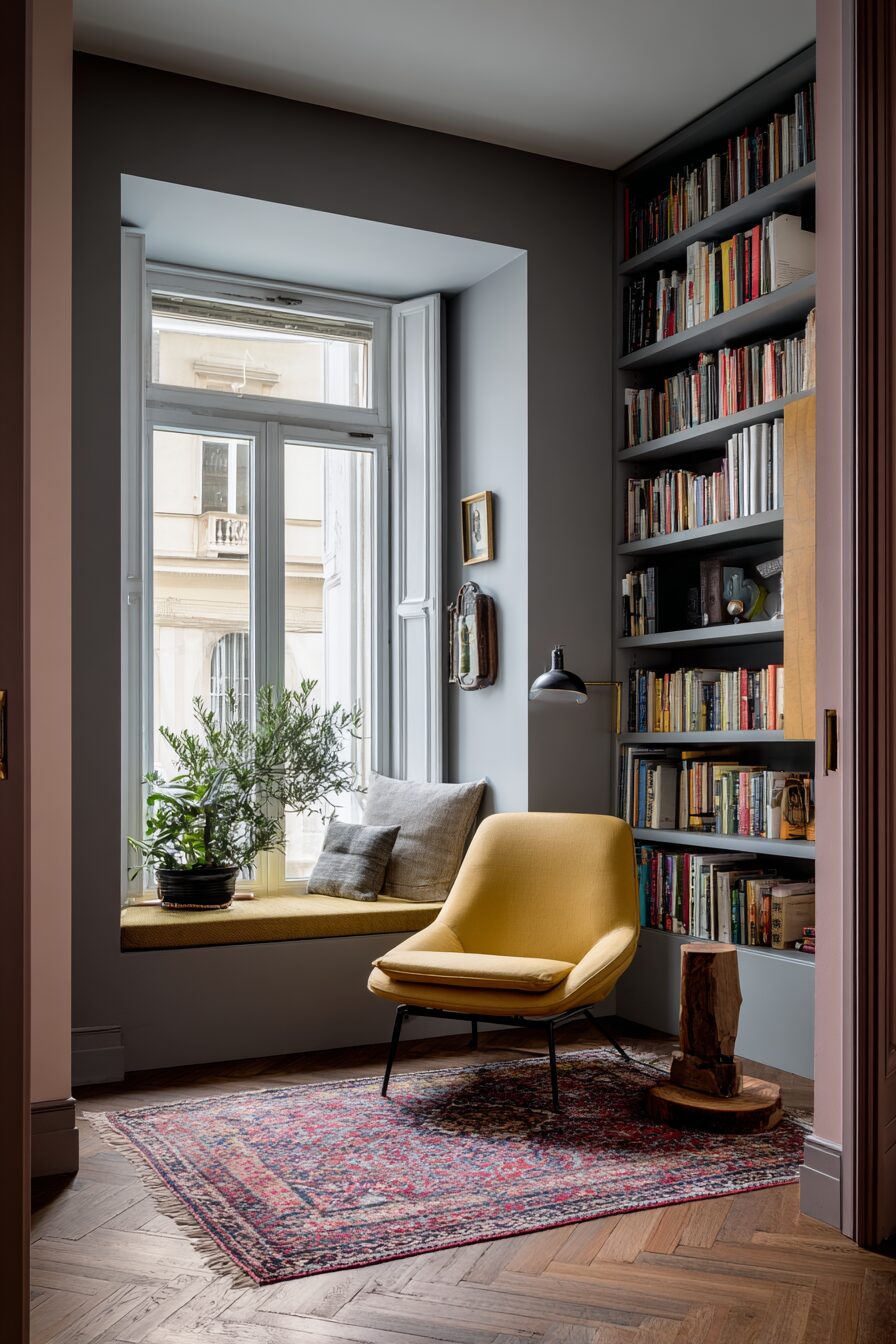Castlecore has emerged as one of the most captivating interior design trends, blending medieval aesthetics with modern comfort to create spaces that feel straight out of a fantasy novel.
This style celebrates ornate details, rich textures, and a sense of historical grandeur that can transform any ordinary home into a personal kingdom.
Statement Stone Walls and Archways
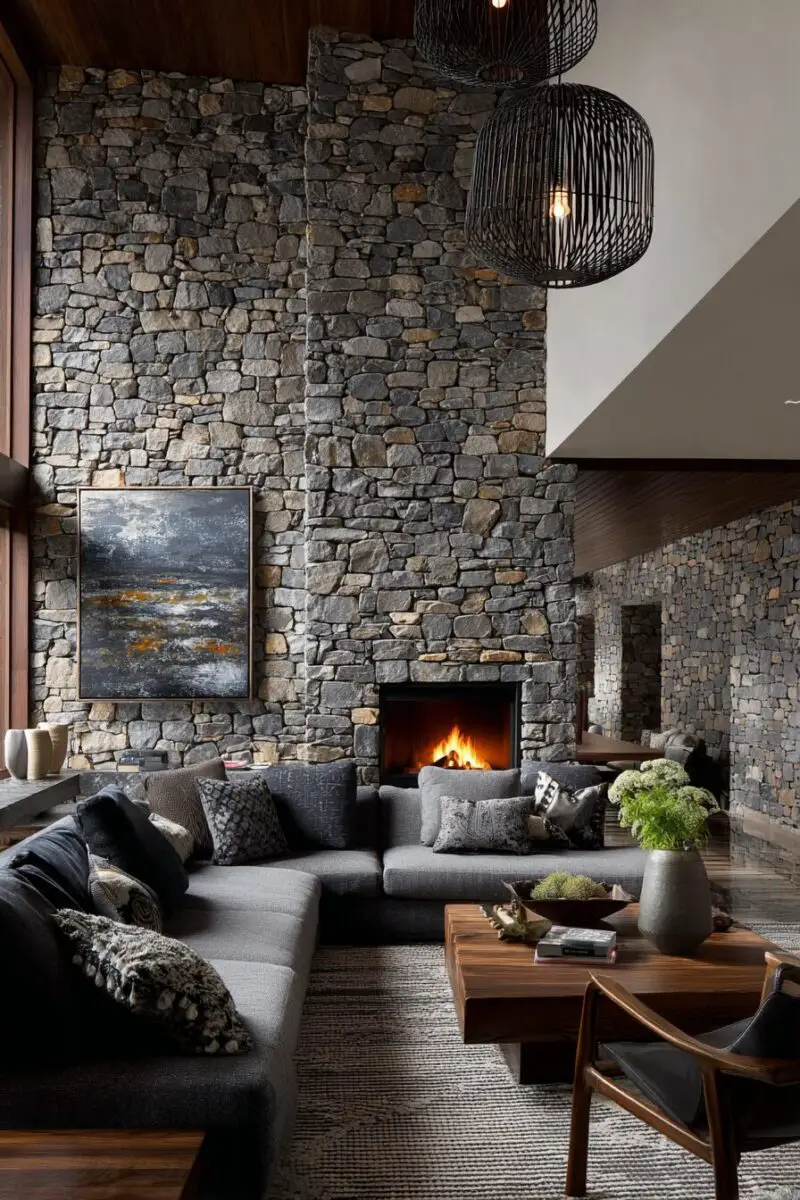
Nothing says castlecore like the rugged texture of stone walls that transport you to another era.
Stone veneer panels offer an affordable alternative to actual masonry work, allowing you to create an authentic castle atmosphere without rebuilding your entire home.
The rough, tactile quality of stone immediately establishes a medieval foundation that grounds your entire design scheme.
Arched doorways represent one of the most distinctive architectural elements of medieval castles, adding drama and a sense of passage between spaces.
You can incorporate archways in various scales, from grand entrances between rooms to smaller arched niches for displaying treasured objects.
Window seats framed with stone create perfect reading nooks that feel like they belong in a castle tower, especially when paired with deep cushions in rich jewel tones.
For a more subtle approach, stone-look wallpaper can provide texture without the weight or permanence of actual stone installation.
Remember that medieval stonework wasn’t perfect – embrace some irregularity in pattern and texture for authenticity rather than seeking perfectly uniform stones.
Combining stone elements with exposed wooden beams creates a structural framework that instantly reads as medieval.
Adding iron wall sconces or torch-style lighting fixtures against stone backgrounds enhances the castle ambiance, especially when they cast dramatic shadows.
The strategic use of mossy or weathered-looking stones can suggest ancient origins and years of history built into your walls.
If full stone walls feel overwhelming, consider stone baseboards or half walls topped with rich wood paneling for a more balanced approach.
Dramatic Tapestries and Wall Hangings
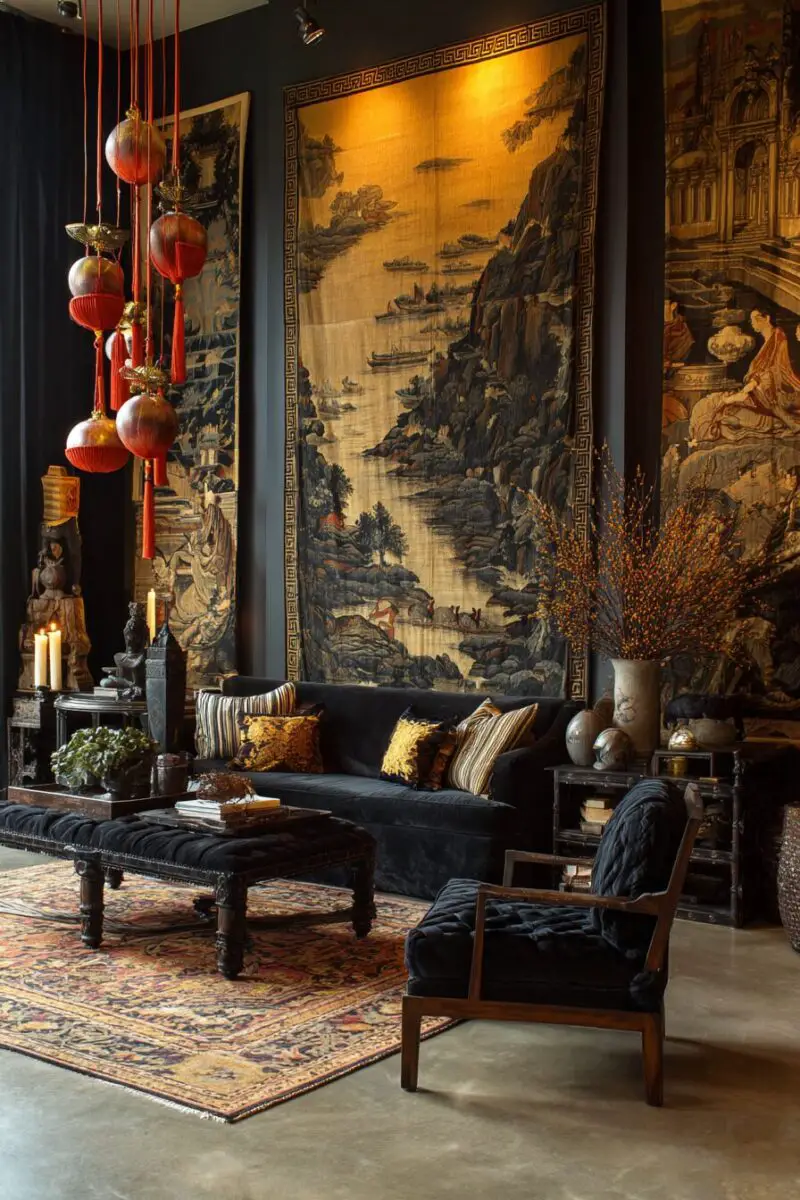
Medieval tapestries serve as both insulation and storytelling devices, making them perfect functional art for your castlecore aesthetic.
Authentic reproduction tapestries featuring historical scenes, mythical creatures, or heraldic designs instantly transform any wall into a castle gallery.
You can find tapestries in various sizes, from massive statement pieces that anchor an entire room to smaller hangings that add texture to narrower spaces.
The richness of woven tapestries adds acoustic dampening properties that create the hushed atmosphere reminiscent of grand castle halls.
Look for tapestries featuring unicorns, dragons, forest scenes, or medieval hunts to capture authentic medieval storytelling traditions.
Hanging methods matter – use decorative rods with finials rather than modern hanging systems to maintain period authenticity.
For a more subtle approach, tapestry pillows or upholstery can bring these intricate designs into your space without dominating entire walls.
Complement your tapestries with wrought iron wall sconces placed strategically to cast light across the textured surface, highlighting the intricate details.
The muted, rich colors typical of medieval tapestries – deep reds, blues, greens, and golds – create a natural color palette around which to build the rest of your room.
Remember that authentic tapestries tell stories – choose designs that resonate with your personal interests or family history for a more meaningful connection.
You can mix tapestries with other wall hangings like shields, crossed swords, or antique maps for a curated collection that suggests a well-traveled noble.
The vertical element that tapestries bring to a room helps accentuate ceiling height, making spaces feel more grand and castle-like.
Use tapestry-inspired fabric as curtains for a coordinated look that frames windows with historical gravitas.
Modern tapestries with medieval-inspired designs offer a contemporary twist that can bridge the gap between authenticity and current trends.
Design Your Dream Room in Minutes!
🏡 Start Creating FREE →Ornate Carved Wooden Furniture
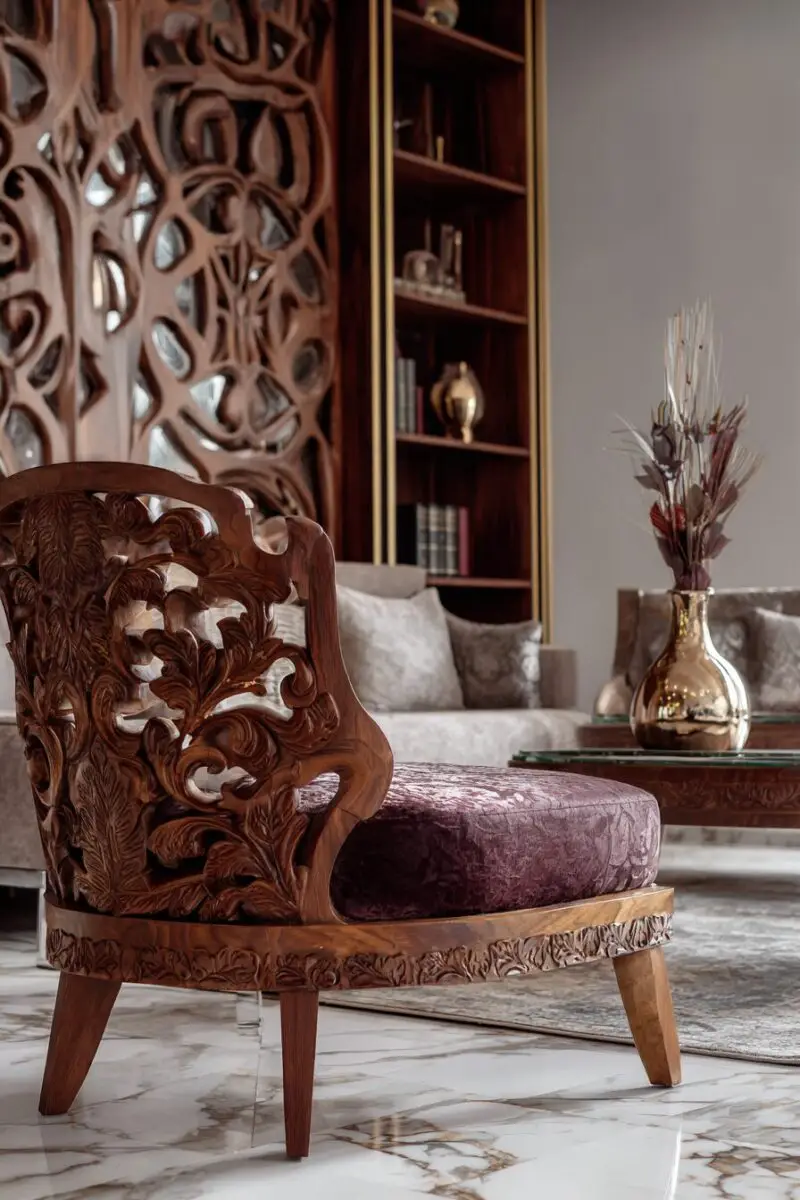
Substantial wooden furniture with elaborate carvings forms the backbone of authentic castlecore interiors.
Look for pieces featuring Gothic arches, quatrefoil patterns, and nature-inspired motifs that reflect medieval craftsmanship.
A heavy wooden dining table with thick legs and visible joinery creates an instant focal point for gathering spaces.
Throne-like chairs with high backs and carved detailing transform ordinary seating into statement pieces worthy of royalty.
Four-poster beds with carved posts and optional canopies create a sleeping chamber fit for nobility, especially when dressed with rich fabrics.
Buffets and sideboards with deep carvings provide both storage and display surfaces for your medieval-inspired treasures.
Wooden chests serve as both functional storage and authentic period pieces, particularly when fitted with decorative iron strapping.
Hunt for furniture with claw feet, lion heads, or other zoomorphic details that were popular in medieval decorative arts.
Weathered or distressed finishes on wooden furniture suggest pieces with stories to tell and histories lived through.
Don’t overlook smaller wooden elements like carved boxes, candle holders, or document cases that add authenticity to tabletops and shelves.
A wooden coat of arms or family crest mounted on a wall or incorporated into furniture creates a personal connection to historical traditions.
Mix woods with different patinas rather than matching everything perfectly – medieval castles accumulated furniture over generations rather than purchasing matching sets.
Remember that craftsmanship should be celebrated – choose pieces where you can see the hand of the maker in detailed carving and joinery.
Candlelit Ambiance with Candelabras

Nothing creates authentic castlecore atmosphere quite like the flickering glow of candlelight dancing across stone walls and wooden beams.
Wrought iron candelabras suspended from ceilings transform ordinary rooms into great halls where shadows play dramatically across walls and furnishings.
Floor-standing candelabras placed strategically in corners create height and drama while providing practical illumination for reading nooks or conversation areas.
Wall-mounted sconces with candle cups (or flame-effect bulbs for safety) establish a rhythmic pattern around room perimeters that mimics medieval lighting schemes.
Candle holders crafted from blackened iron, burnished brass, or pewter add authentic material texture while reflecting light in different ways.
Church-inspired candlesticks with gothic detailing bring ecclesiastical gravitas to dining tables and side tables.
Hurricane lanterns with medieval-inspired metalwork protect flames while casting patterned shadows that add visual complexity to your spaces.
Remember that medieval lighting was purposeful – place light sources where they serve functions like illuminating pathways, reading areas, or dining surfaces.
Candlelight naturally creates intimacy and draws people closer together, encouraging the same kind of communal gathering that characterized castle life.
For everyday practicality, consider flame-effect LED candles in authentic holders, providing the ambiance without fire hazards or wax drippings.
Mirrors or reflective surfaces placed strategically behind candle groupings amplify light while adding depth to darker corners.
Consider incorporating candle chandeliers above dining tables for dramatic overhead lighting that casts magnificent shadows across faces and table settings.
Wrought iron candle stands with scrollwork and fleur-de-lis details add authentic medieval design language to your lighting scheme.
The warm amber glow of candlelight is particularly flattering to the rich color palette of castlecore interiors – deep reds, blues, and golds come alive under this natural illumination.
Luxurious Velvet and Brocade Textiles
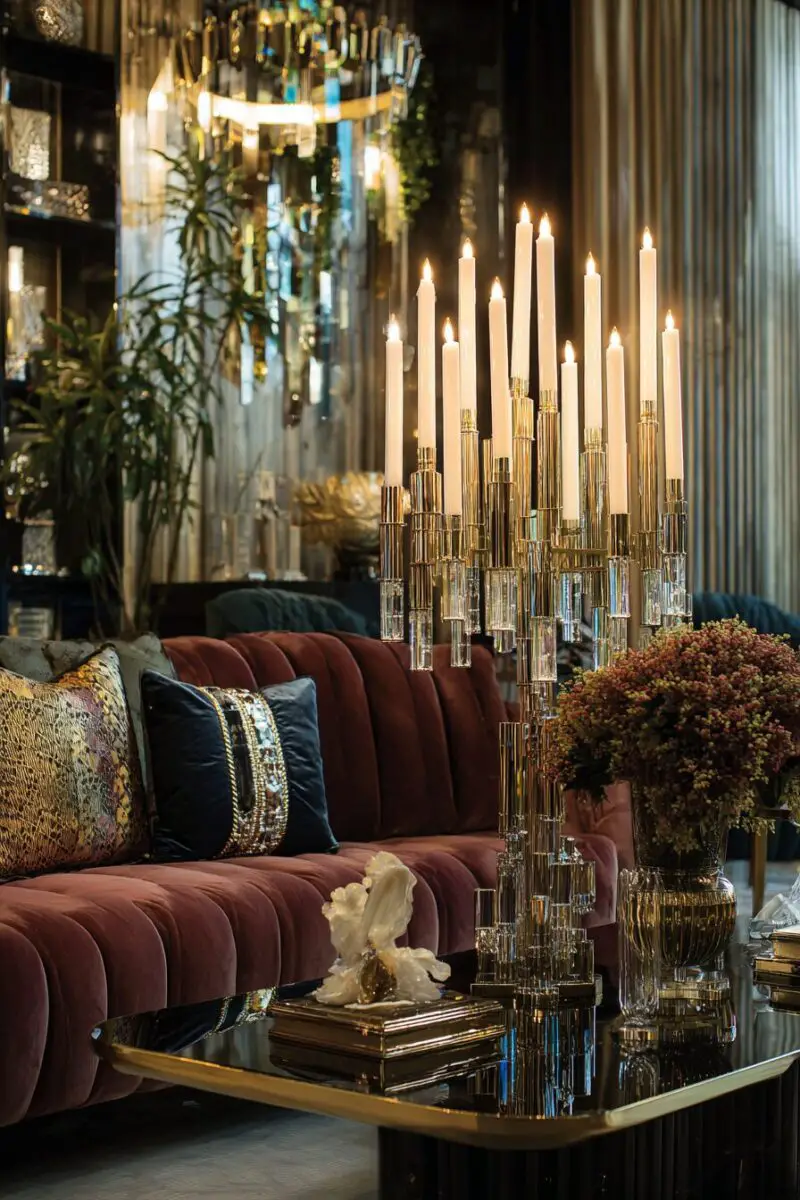
Rich textiles form the essential softening elements that balance the heavy stone and wood elements of castlecore design.
Velvet draperies in jewel tones create dramatic framing for windows while providing authentic insulation against drafts, just as they would have in actual castles.
Look for brocade fabrics featuring damask patterns, heraldic motifs, or fleur-de-lis designs for upholstery that speaks to medieval craftsmanship.
Layered textiles create depth and warmth – consider throws draped over chair backs, tapestry pillows against velvet upholstery, and fur accents on wooden benches.
Canopy beds draped with heavy fabrics create private sleeping chambers while adding vertical drama to bedrooms.
Table runners in rich, embroidered fabrics instantly elevate dining experiences to banquet status, especially when paired with pewter or brass tableware.
Consider floor cushions in sumptuous fabrics for alternative seating that encourages gathering around hearths or low tables.
Window treatments should be substantial – full-length, lined curtains with decorative tie-backs and valances create the layered, opulent look characteristic of castle interiors.
Look for fabrics with metallic thread details that catch candlelight and add subtle sparkle to your textile elements.
Don’t forget bedding – layered linens, embroidered coverlets, and fur throws create sleeping quarters worthy of nobility.
Embroidered wall hangings offer an alternative to heavy tapestries while still providing authentic textile art for your walls.
Banner-style hangings with family names, meaningful Latin phrases, or heraldic symbols add personal significance to your textile collection.
Remember that medieval textiles served practical purposes beyond decoration – draft-excluding door curtains, table coverings to protect wood, and bed hangings for warmth all combine function with beauty.
Textiles provide opportunities to introduce pattern and color variation into spaces dominated by natural stone and wood tones.
TRENDING NOW
Explore Magic With 10+ Afrohemian Decor IdeasGothic Stained Glass Elements
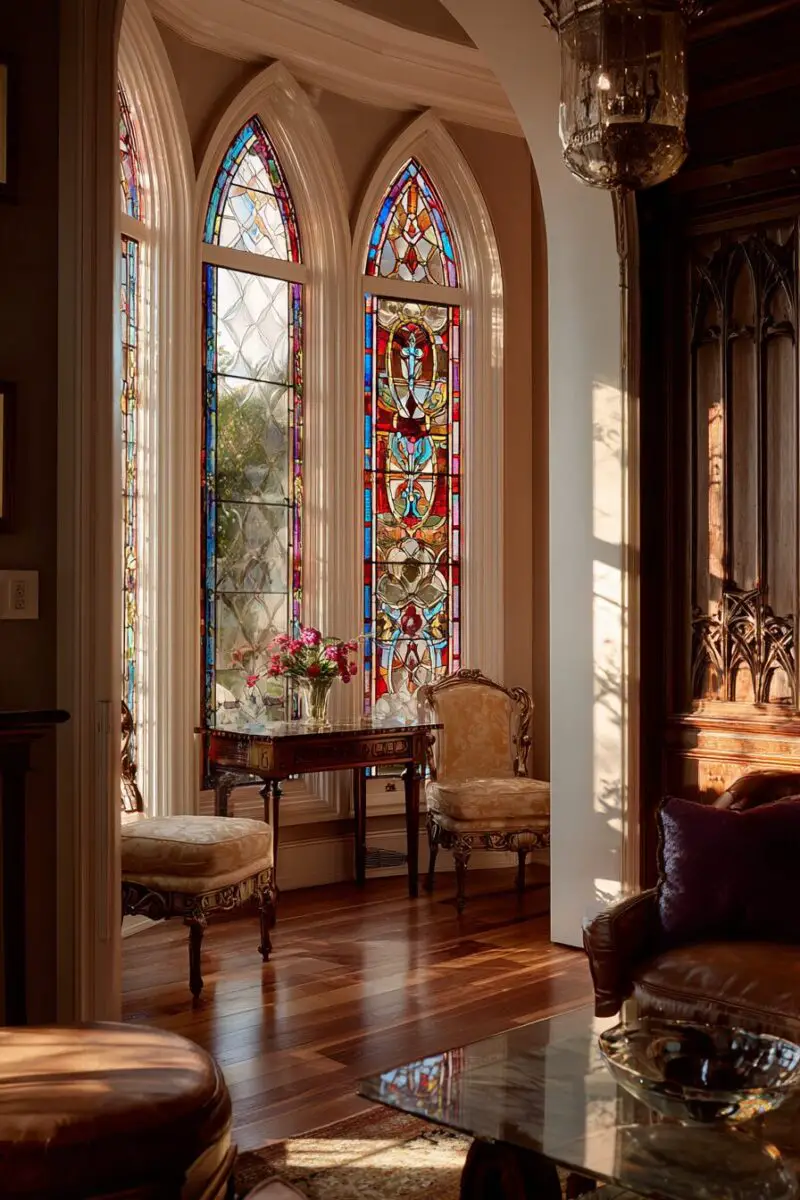
Stained glass elements introduce magical colored light that transforms ordinary spaces into sacred-feeling sanctuaries.
You don’t need cathedral-sized windows to incorporate this element – consider small stained glass panels hung in existing windows where they’ll catch natural light.
Lanterns or candle holders with stained glass panels create colored light patterns that dance across walls when illuminated from within.
Look for geometric patterns like quatrefoils, trefoils, and lancet shapes that reference Gothic architectural details without necessarily depicting religious scenes.
Stained glass table lamps create pools of colored light that add warmth and dimension to darker corners.
Pendant lights with stained glass shades bring the medieval element overhead, casting beautiful patterns on ceilings and upper walls.
For a more substantial architectural element, consider installing a stained glass transom above doors or as a room divider that allows colored light to flow between spaces.
Decorative mirrors with stained glass borders combine the practical function of reflection with the artistic beauty of colored glass.
Cabinet doors with stained glass panels transform ordinary storage into display space for treasured items illuminated from within.
Remember that medieval stained glass featured a distinctive color palette – rich blues, ruby reds, emerald greens, and golden ambers – that naturally complements other castlecore elements.
Stained glass suncatchers hung at different heights create an ethereal effect as sunlight moves through the space throughout the day.
Even small touches like stained glass picture frames or trinket boxes can introduce this distinctive medieval art form without major renovations.
The way stained glass transforms ordinary sunlight into jewel-toned illumination creates a magical quality that perfectly captures the fantasy element of castlecore design.
TRENDING NOW
13 Chic Feminine Decor Ideas For Your ApartmentMedieval-Inspired Dining Arrangements
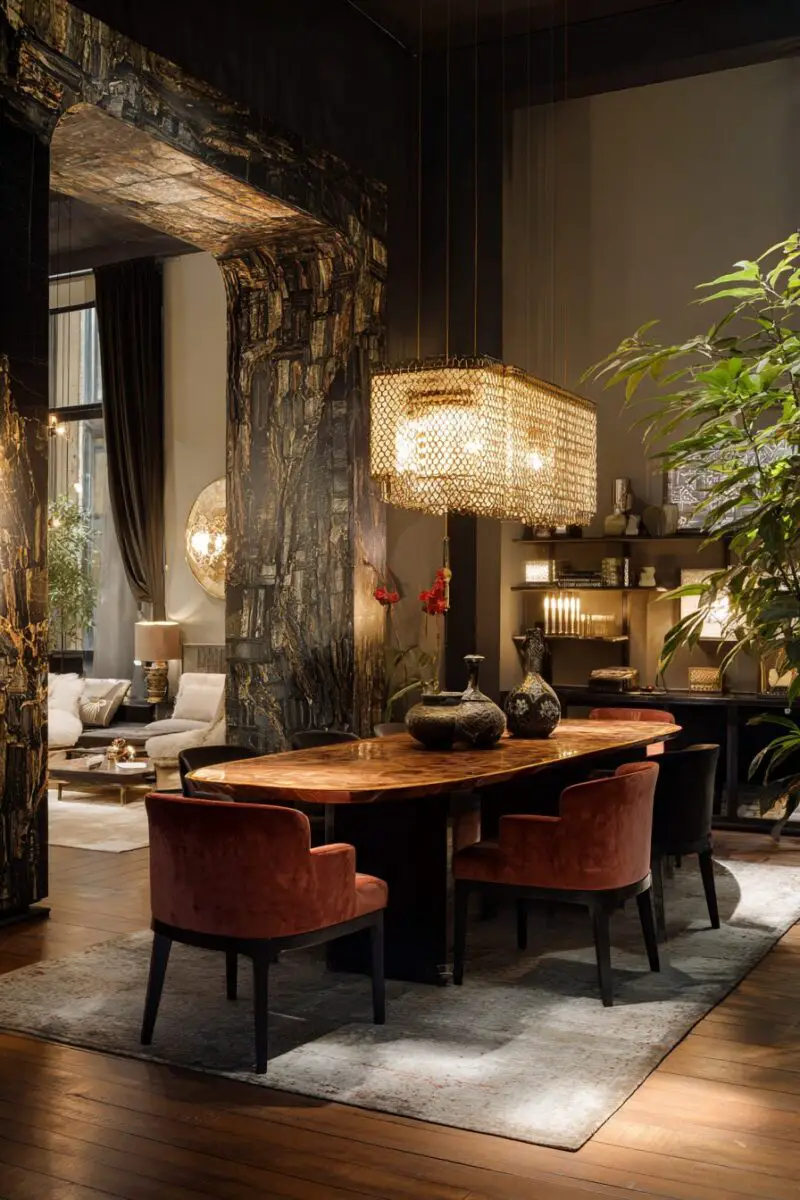
The great hall dining experience represents one of the most iconic elements of castle life that you can recreate in your home.
A substantial wooden table with bench seating along the sides and more ornate chairs at the heads creates an authentic medieval dining arrangement.
Put a tableware that references medieval dining traditions – pewter plates, goblets with stems, and serving pieces with Gothic detailing.
Overhead lighting should be dramatic – iron chandeliers suspended above the table cast appropriate shadows while providing functional illumination.
Table linens in rich fabrics with embroidered edges add texture and color while protecting wooden surfaces.
Centerpieces featuring candelabras, fresh herbs, seasonal fruits, and rustic flowers create historically accurate table decorations that engage all senses.
Salt cellars – small decorative containers that held precious salt – make historically accurate table accessories that serve both decorative and functional purposes.
Dining chairs upholstered in velvet or leather with nail head trim reference medieval seating while providing modern comfort.
Wall decor surrounding your dining area should reinforce the medieval theme – consider banners, tapestries, or mounted ironwork that creates context for your dining experience.
For special occasions, place card holders featuring miniature shields or crowns add playful references to medieval banquets.
Put rustic wooden chargers under plates to add layered texture to place settings.
Remember that medieval dining was communal – design your dining space to encourage conversation and connection, with seating arrangements that facilitate sharing both food and stories.
Serving pieces with historical references – like a wassail bowl for hot drinks or bread boards for breaking bread together – add functional authenticity to your dining rituals.
Incorporate herbs both as ingredients and decorative elements – small potted herbs along a table runner reference medieval kitchen gardens while providing fragrance.
Hidden Nooks and Reading Corners

Castle architecture featured countless tucked-away spaces, and recreating these intimate nooks adds authentic character to your castlecore home.
Window seats framed with stone or heavy wood create perfect reading retreats, especially when topped with plush cushions in rich fabrics.
Convert an unused closet into a hidden reading nook with wall sconces, a small bench, and shelving for books and treasures.
Canopy arrangements using ceiling-mounted curtain rods and heavy fabrics can section off corners of larger rooms to create intimate retreats within open spaces.
Under-stair spaces transformed with cushions, small shelves, and proper lighting make magical hideaways that reference the secret passages of medieval architecture.
Alcoves framed with Gothic-inspired arches create natural niches for reading chairs, small desks, or display areas for treasured objects.
Window nooks benefit from the addition of stained glass elements that cast colored light across your reading material and create a sanctuary-like atmosphere.
Build g a window-facing bench with storage drawers underneath for blankets and pillows, combining coziness with practical storage.
Proper lighting is essential for reading nooks – adjustable wall sconces with warm-toned bulbs provide task lighting while maintaining medieval atmosphere.
Incorporate small side tables or built-in shelving for keeping reading materials, beverages, and personal treasures within arm’s reach.
Textiles play a crucial role in creating cozy nooks – layer pillows of varying sizes, add weighted throws, and consider floor cushions for extra seating.
A small writing desk with Gothic details tucked into a corner creates a correspondence nook worthy of penning medieval-style missives.
Add a curtain that can be drawn to completely enclose your nook, creating a room-within-a-room that offers privacy and deeper immersion in your reading.
Sound management helps create truly cozy nooks – tapestries, heavy curtains, and upholstered elements naturally dampen sound and create hushed retreats.
Remember that castle nooks often served practical purposes – incorporate storage, display space for collections, or functional work surfaces to make your nook both beautiful and useful.
Heraldic Symbols and Crests
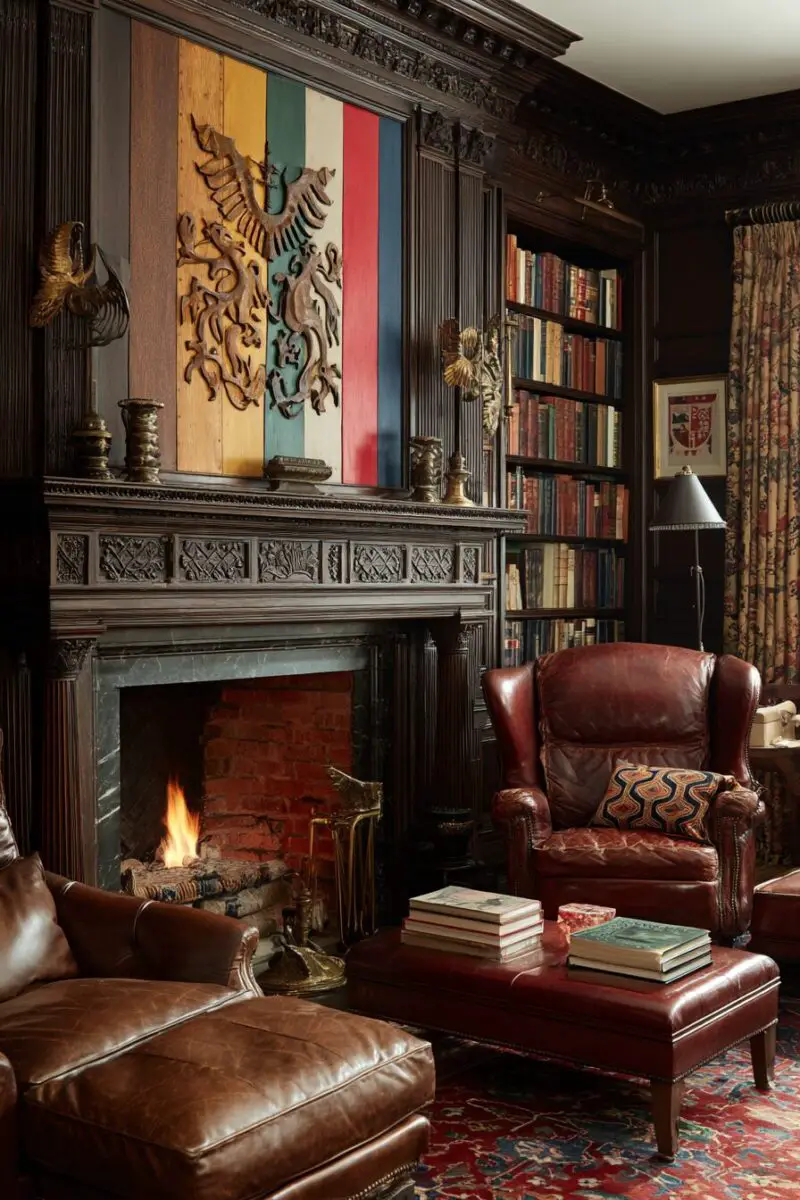
Heraldry adds authentic medieval character while offering opportunities to incorporate personal meaning into your castlecore decor.
Research your own family name to discover if you have historical coat of arms that could be incorporated into your design scheme.
If no family crest exists, designing a personal coat of arms with symbols meaningful to you creates a custom heraldic element that feels both authentic and personal.
Shields mounted on walls, either individually or grouped in arrangements, create instant castle atmosphere while serving as artistic focal points.
Look for bedding, upholstery fabrics, or tapestries featuring heraldic motifs like lions, eagles, dragons, or fleur-de-lis symbols.
Incorporate heraldic elements in unexpected places – painted on furniture, embroidered on pillows, or etched on glassware.
Door knockers or door plates featuring heraldic symbols make even modern entries feel like castle portals.
Banners suspended from decorative rods add vertical interest while incorporating heraldic designs in a historically accurate format.
Put a custom rubber stamp with your personal heraldic design for sealing correspondence, marking personal books, or creating custom wrapping paper.
Bookplates featuring heraldic designs add medieval character to your library while personalizing your collection.
Remember that color was highly significant in heraldry – incorporating traditional heraldic colors like azure blue, gules red, or or gold adds authenticity to your design scheme.
Wax seals with heraldic stamps make beautiful decorative elements when displayed in shadow boxes or glass vessels.
Smaller heraldic details work beautifully on decorative boxes, letter openers, or desk accessories, bringing the castle theme to functional everyday items.
Incorporate heraldic motifs in bathroom details like embroidered hand towels, shower curtains, or even subtle tile patterns.
The graphic clarity of heraldic designs makes them particularly effective as silhouettes in window treatments, lamp shades, or wall stencils.
Enchanted Indoor Gardens
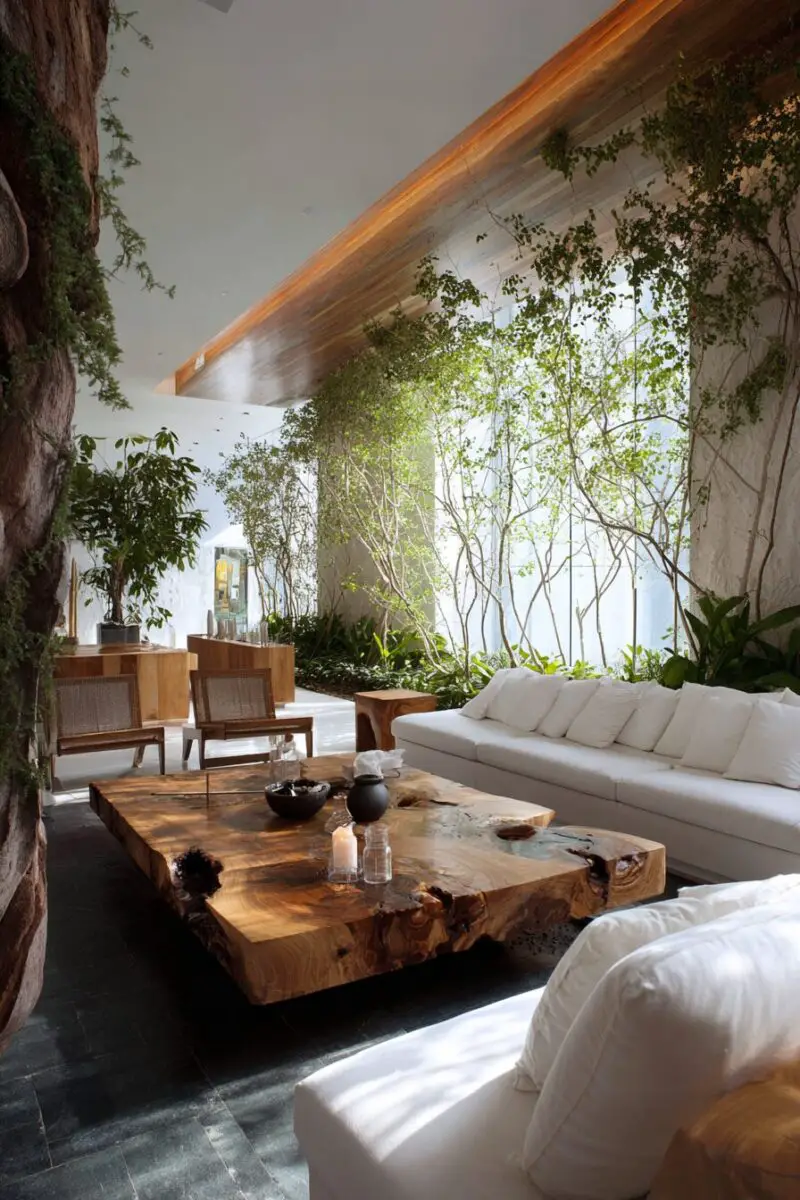
Medieval castle gardens were places of both practical cultivation and magical respite, elements you can recreate within your modern castle home.
Create an indoor herb garden with varieties known to medieval gardeners – rosemary, sage, lavender, and thyme not only look beautiful but offer wonderful fragrances.
Plant stands with Gothic architectural details provide perfect stages for displaying your indoor greenery at various heights.
Look for containers with medieval influences – stone urns, terracotta vessels with relief designs, or metal planters with Gothic detailing.
Incorporate climbing plants on decorative trellises to create living walls that reference castle courtyard gardens.
Put a tabletop fountain with stone details to add the soothing sound of water – a feature highly prized in medieval garden design.
Plant selections should favor those with historical connections – roses, foxgloves, and holly all featured prominently in medieval gardens and mythology.
Wall-mounted planters designed to look like stone sconces create living wall decorations that combine architecture and nature.
Terrariums enclosed in Gothic-inspired glass cases create miniature magical worlds that reference the enclosed garden tradition of medieval design.
Incorporate preserved botanical elements like dried flowers, herbs hanging from ceiling beams, or pressed flowers framed under glass.
Bird cages repurposed as plant holders add whimsical vertical elements while referencing the tradition of keeping songbirds in castle gardens.
Stone or concrete garden statuary – like small gargoyles, dragons, or mythical creatures – add fantasy elements among your plantings.
Remember that medieval gardens served magical and medicinal purposes – grouping plants known for their historical uses adds an authentic layer of meaning to your arrangements.
The interplay of carefully tended plants with stone, wood, and metal elements perfectly encapsulates the castlecore aesthetic’s balance of nature and architecture.
Castlecore isn’t just about decoration – it’s about creating an immersive experience that transports you to another time and place.
By thoughtfully incorporating these elements, you can create a home that feels both magical and personal, where every detail contributes to the overall atmosphere of medieval grandeur.
Remember that authentic castles developed over time, accumulating treasures and stories with each passing generation.
Allow your own castlecore spaces to evolve similarly, adding pieces that speak to you and reflect your personal connection to this enchanting aesthetic.

